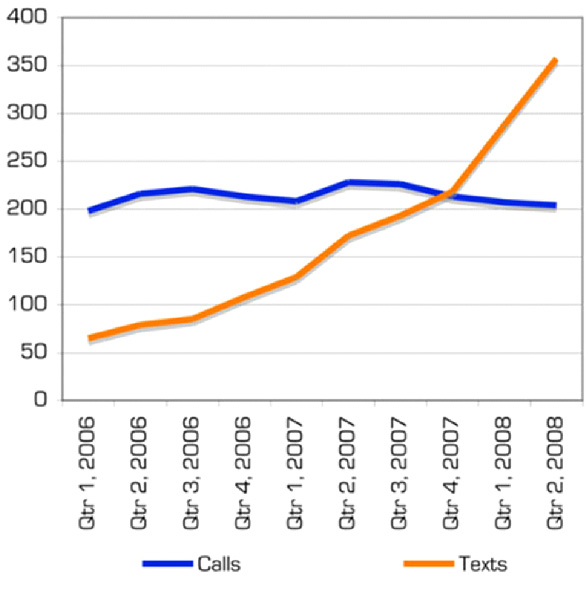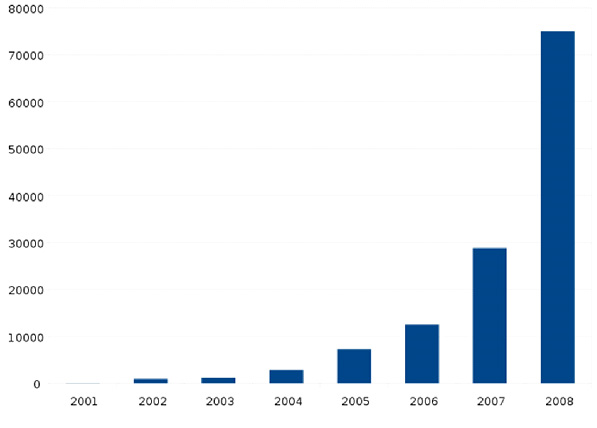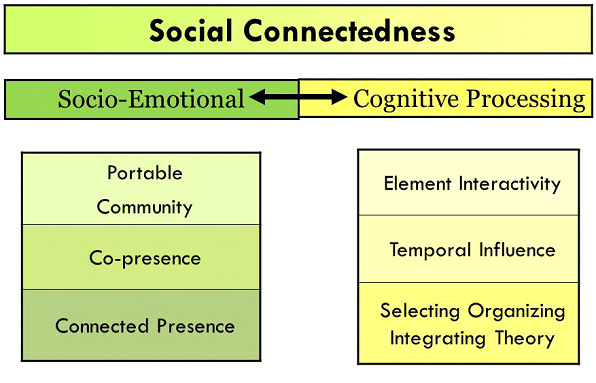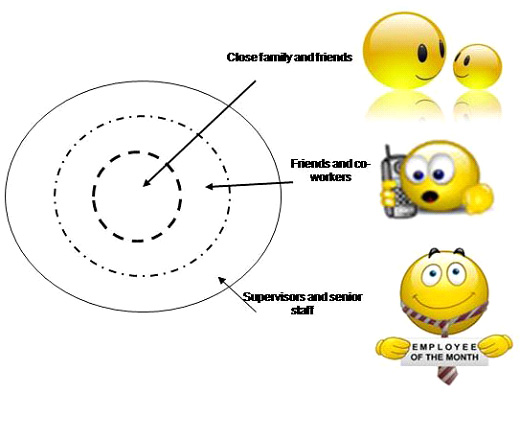Key Takeaways
- Providing students with portable communities of support through mobile phone texting offers one way to give them a sense of social connectedness.
- Increasing a sense of social connectedness encourages healthier emotional well-being among students, reducing potential feelings of isolation from the campus community.
- Texting may help improve participation by and performance among students, although definitive proof will require a more rigorous examination of the actual effects on their performance and perceptions of emotional well-being.
Informal feedback revealed that newly admitted graduate students at a college in New York City felt isolation in a new urban and study environment. To address this perception, I helped design and implement an event text-messaging service between 2008 and 2010 in an attempt to determine whether it could foster a greater sense of social connectedness.
Social connectedness is a concept used by social theorists and psychologists to explain the occurrence, value, quantity, and regularity of exchanges we have with people in our social network of family, friends, and acquaintances. These connections can be fostered in the physical realm of life as well as in online and offline spaces. The notion of social connectedness has often been used to characterize degrees of interpersonal trust, attachment security, social competency, and a sense of belonging.1
We chose to explore whether text messaging on a mobile device could encourage feelings of social connectedness — remotely — for two reasons:
- First, text messaging has become the preferred mode for communicating remotely in the past several years.
- Second, text messaging allows users to reach out — discreetly — in a way not possible with voice calling.
The texting service study provided useful insights into the processes associated with and manifestation of social connectedness. In sending campus and city event information regularly to students who signed up to receive event information, we were able to establish rapport with them in both the virtual and physical worlds. An analytical framework was then constructed to interpret the participants' texting practices. The study implemented both qualitative and descriptive statistical methods for data collection and analysis.
The Study
The data gathered from this ongoing study represent an aspect of my larger doctoral research project, conducted with the assistance of two coders and two others in my doctoral cohort.
A pilot study of 33 participants in 2008 was followed by a second study of 33 students in 2010. Despite the small numbers, the study results provide guidance for future research.
Nearly 1,200 text messages were exchanged over a four-week period. In addition to receiving event information, the participants freely reached out to the texting service requesting support during job interview preparation or stressful work and academic times.

Figure 1. Average Number of Calls vs. Text Messages (2006–08) in the U.S.
Source: Nielsen Report, 2008
About the Text-Messaging Service
Text messaging is unique in that it allows users to discreetly reach out to other users of mobile devices wherever there is a cell phone signal. It also caters for bridging the real-virtual divide through a tacit understanding of its near synchronous and asynchronous communication expectations. In short, mobile phone texting can offer a means to be connected with networks of contacts while on the move, thus enhancing feelings of socio-emotional support.
The initiation of a service like this was made possible by the widespread use of texting by students and the U.S. population in general, especially since 2007 (Figure 2).2

Figure 2. SMS Messages (in Millions) Sent per Quarter (2006–08) in the U.S.
Source: Cellsigns
Soon after beginning the 2010 study, we noticed a rise in the frequency of texting by the study participants compared with the pilot participants of a year earlier. The latter group identified the switch to smartphones with the familiar QWERTY keyboard and a bigger screen space as the major reason for the increased activity — smartphones made texting easier for this population.
The text-messaging service disseminated information about upcoming on- and off-campus events. Messages were spaced with one- or two-day gaps for two reasons:
- Prior to enrolling for the study, participants indicated they did not want to be "spammed" or "flooded with text messages."
- Participants did not to want to feel "overwhelmed" or pressured by the messages.
Although texting is generally a one-to-one channel, this event-information texting service followed a one-to-many model — that is, it sent a single text message out to the 33 graduate students participating in the study. Responses ranged from requests for more details and travel directions, to confirming attendance or providing reasons for not being able to attend the scheduled events. As the study progressed, the participants also initiated text conversations with me that were not about the events, but their general well-being.
Texting Initiatives in Education
Other initiatives in educational settings informed the planning behind this texting study:
- A blended learning approach at the University of Wolverhampton in the United Kingdom utilized texting for at-risk first year undergraduate students by sending tutorial venue updates as well as study and exam tips.3
- Similarly, a professor of the Institute for Higher Education at Griffith University in Australia targeted an entire first-year group of students by texting them with various forms of information designed to help them adjust to university life and study demands.4
- The online service of the BBC in the United Kingdom offers support for exam revision and preparation to students aged 14 through 16 years old: http://www.bbc.co.uk/gcsebitesize/. The original initiative from 2003 provided a texting component that proved so popular it drew the interest of adult learners as well. Due to high demand for this service, the BBC was forced to charge for the previously free text messages, which resulted in a noticeable drop in usage.5
Theoretical Framing of the Study
Framing the study through the lens of cognitive load theory and socio-emotional factors (see Figure 3) revealed the ways in which mobile phone texting colors social interactions. It also gave us insights into the dynamics of the connected communities, in terms of how they are created and maintained.

Figure 3. Theoretical Framework for Social Connectedness Through Texting
The subsequent qualitative interview phase identified two main categories of socio-emotional impact associated with texting: as people's mobile communities became more portable, their sense of connectedness to and co-presence with friends and family grew through reciprocal texting.
In the same way, the degree to which the students used and developed texting language directly related to the level of confidence or intimacy they felt about individual contacts in their portable communities. Variable word spellings and the use of abbreviations not only requires extra cognitive processing associated with decoding, but could be viewed as being exclusive — understood only by the handful of people using them. Thus, the use of such texting languages could be interpreted as noninclusive group practice, but this did not happen — the word forms constantly evolved, and participants happily shared meanings.
Time variance in response rates to text messages revealed the depth of rapport with a particular texting buddy. In fact, participants expressed concerns about the time necessary to respond to or receive a response from a text message. The temporally fluctuating nature of asynchronous and near-synchronous text messaging — as opposed to a synchronous voice conversation — either reinforced or reduced stress levels. Speedy responses were found to increase the feelings of social connectedness among texting parties as well as dispel feelings of isolation, helping facilitate closer (virtual) bonds.
Expanding and Fluid Portable Communities
Given the regularity of the participants' daily routines, deviations from the norm tended to be expressed through the posting of personal commentaries about travel, events, or status updates. Such "micro-moments of affect" drew attention to the nonlinear nature of mobile technology and emphasized the fluidity of the portable texting communities.
Portable texting communities can be characterized as a series of radiating circles always in a state of flux, with a focal point being the participant and expanding out according to different levels of trust (see Figure 4). Perceptions of trust are directly proportional to texting frequency and synchronicity in text message response time. Similarly, an increase in the use of abbreviated word forms and informal tone occurred with contacts closer to the center. The further away from the center, the more formal the language and the fewer shortened words.

Figure 4. Expanding, Permeable, and Fluid Texting Community Circles
Texting Service Feedback
In addition to personal experiences, the group experience was important to the study participants. Although they came from different departments and units in their postsecondary institution, their comments of feeling "privy to receive the text messages" and "being in the know of events" suggested a degree of social connectedness while mobile, not necessarily possible in another modality. Those stationed off campus during internships also indicated feeling more connected to the institution as a result of the increased text messaging. Although this connectedness was not always understood in the same way, the participants felt positively about the experience overall. As one suggested in the post-study survey:
"It was nice to feel like I had all these extra friends! The activities were thoughtful and interesting, wish I could have done more … but life is very full at the moment!"
Initial Observations
One observation to emerge from my experience of helping coordinate the study was the significant amount of time needed to create and send messages, read responses, and reply. It would be important to consider — in advance — staffing and support for another campus instituting a similar service; indeed, such a texting service probably could scale better at a departmental level than as an institution-wide initiative. However, a texting service would only appeal to those students willing to open their texting circle to a university representative. Moreover, not all students would be seeking social connectedness through such a service.
Notwithstanding, those who found both the service useful and their portable communities of support expanding were more eager to embrace the virtual realm of asynchronous texting. Quick responses helped make these communities more fluid. Indeed, any delays in response were frowned on. That is, speedy responses helped foster a sense of social connectedness and co-presence among students. Shared texting word permutations similarly brought people together in a closer texting circle. All these factors support my thesis that text messaging could support emotional well-being among graduate students.
Recommendations
Admittedly, the results from this small study offer limited guidance to campuses wanting to institute a similar service or research such initiatives. However, some recommendations emerged from analysis of the study results.
- Future event information texting programs should consider the students' scheduling and time-management issues in greater depth. Participants noted that prior event notification allowed them to adjust schedules to accommodate event attendance. They also appreciated reminders that provided additional details.
- Future programs should be tested in small postsecondary settings. Smaller campus entities can better combine the virtual with face-to-face connections for evaluation. As such, tacit solidarity between the integrated texting service and a potential texting cohort is encouraged.
- Such a texting service could consider facilitating intradepartmental connections for new students. These students would typically be going through the same registration steps and attend the same orientation meetings, and a texting service could alleviate feelings of isolation.
- The texting service should provide a single piece of information per message. This targeted approach would alleviate feelings of overload. It would also better serve the plurality of devices used by the students and facilitate a faster grasp of the range of texting permutations.
- Limitations associated with portable device contracts, as well as social and cultural attitudes, need to be considered. Any initiative would need to determine contingencies associated with telecommunication company service agreements, including single-carrier exclusivity, nonexistent reception, and varying charges and rates. Before the implementation of any texting service, it would be necessary to accommodate a range of contractual limitations, individual preferences and needs, and any number of cultural and socio-economic considerations.
Broader Implications
The short-term study raised other questions that will help plot a future research trajectory. Indeed, there have been few formal studies that measure the impact of socio-emotional and cognitive factors on social connectedness through texting.6
This study revealed the extent to which mobile texting reinforces social connectedness in terms of socio-emotional and cognitive considerations. It also revealed diversity in practice and delivery given how much input and output interfaces differ. Just as each individual is unique, so too do mobile phone users have unique genograms, indicating patterns among individuals and usage.
Lessons learned from this study could offer guidelines for designers of social connectedness systems. The focus could be on measuring social connectedness, types of content mediated by sociable media, and the interaction afforded by such systems.7
In terms of element interactivity considerations, there are undoubtedly avenues to explore in terms of making creative use of the limited screen sizes and linguistic constraints to deliver content, offer academic support, and cultivate social connectedness.
No doubt opportunities abound for implementing text-messaging services at institutions of higher education in a variety of ways, from enhancing existing counseling or residential student assistance services to supporting students new to the city or country. Moreover, they have the potential to host a platform of texting practices, communication media preferences, interactions with online social media, and so forth. Importantly, what these services can offer need not be seen as independent or even hierarchical in approach, but rather as parallel to different communication modalities.
Concluding Thoughts
The text message application of a handheld device such as a smartphone can engender social connectedness in many ways, not least of all in helping enhance the users' emotional well-being. This study revealed how a group of graduate students communicating through text messaging developed enhanced interpersonal opportunities. Although apparently ephemeral, micro-moments of co-presence and feelings of connectedness, strung together over time, almost certainly helped reduce feelings of isolation in students who spend much time off campus. In the long run, this could positively impact their academic performance, helping them build stronger emotional health and resilience and reinforcing their affinity with the institutional community. These implications — although based on initial results — argue for more extensive study of text messaging as a way to support graduate and other students who spend much of their time separated from the physical campus community.
- Richard M. Lee and Steven B. Robbins, "Measuring Belongingness: The Social Connectedness and the Social Assurance Scales," Journal of Counseling Psychology, vol. 42, no. 2 (1995), pp. 232–241.
- In fact, a study by the Nielsen Company in 2008 showed the extent to which text messaging had surpassed all other modes of communication on mobile devices (Nielsen Company, "In U.S., SMS Text Messaging Tops Mobile Phone Calling," Nielsenwire, September 22, 2008; see also Zach Miners, "Could Texting Be Good for Students?" US News & World Report,October 29, 2009).
- Brendan Riordan and John Traxler, "The Use of Targeted Bulk SMS Texting to Enhance Student Support, Inclusion and Retention," paper presented at the Wireless and Mobile Technologies in Education, IEEE International Workshop on Wireless and Mobile Technologies, November 28–30, 2005. See also Laura Naismith, Peter Lonsdale, Giasemi Vavoula, and Mike Sharples, "Literature Review in Mobile Technologies and Learning," FutureLab Series, Report no. 11 (2004), pp. 31–33.
- Louise Horstmanshof, "Using SMS as a Way of Providing Connection and Community for First-Year Students," Beyond the Comfort Zone: Proceedings of the 21st ASCILITE Conference, Perth, Australia, 2004.
- Naismith et al., "Literature Review in Mobile Technologies and Learning."
- AeRee Kim and Hitoshi Mitomo,"Impact of Mobile Usage on the Interpersonal Relations," International Journal of Digital Economics, vol. 61 (2006), pp. 79–94; Heather Horst and Daniel Miller, "From Kinship to Link-Up: Cell Phones and Social Networking in Jamaica," Current Anthropology, vol. 46, no. 5 (2005), pp. 755–778.
- Thomas Visser, Pavan Dadlani, Daan van Bel, and Svetlana Yarosh, "Designing and Evaluating Affective Aspects of Sociable Media to Support Social Connectedness," Proceedings of the 28th International Conference on Human Factors in Computing Systems, Atlanta, Georgia, April 10–15, 2010.
© 2011 Dominic Mentor. The text of this EQ article is licensed under the Creative Commons Attribution-Noncommercial-No Derivative Works 3.0 license.
